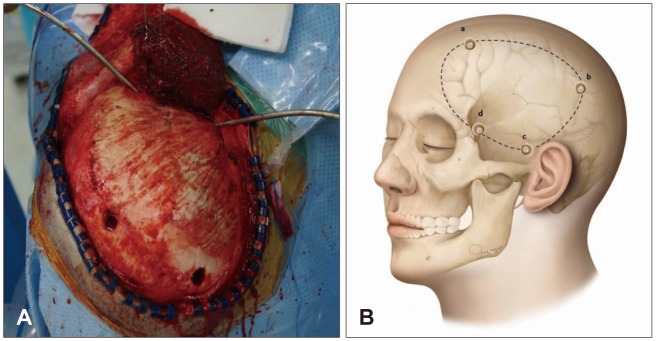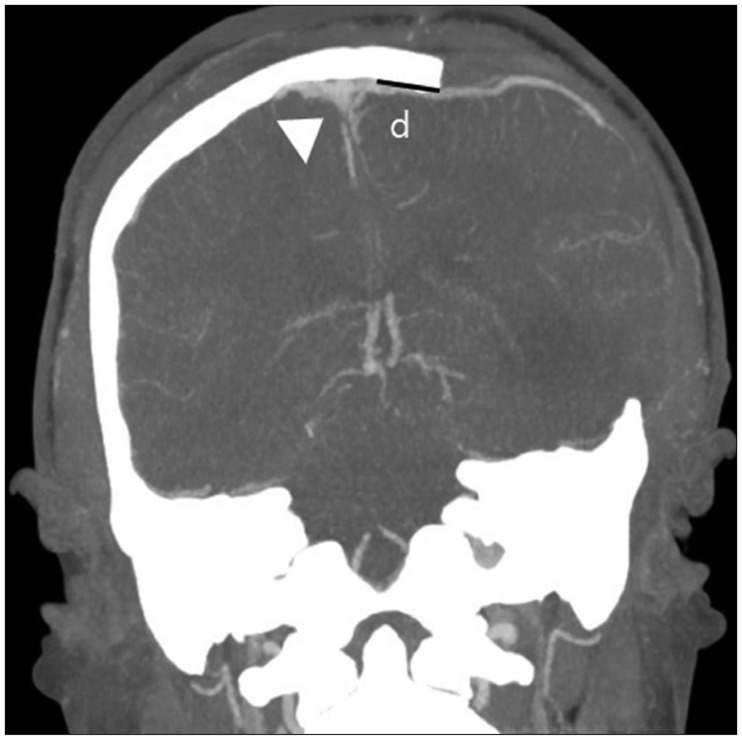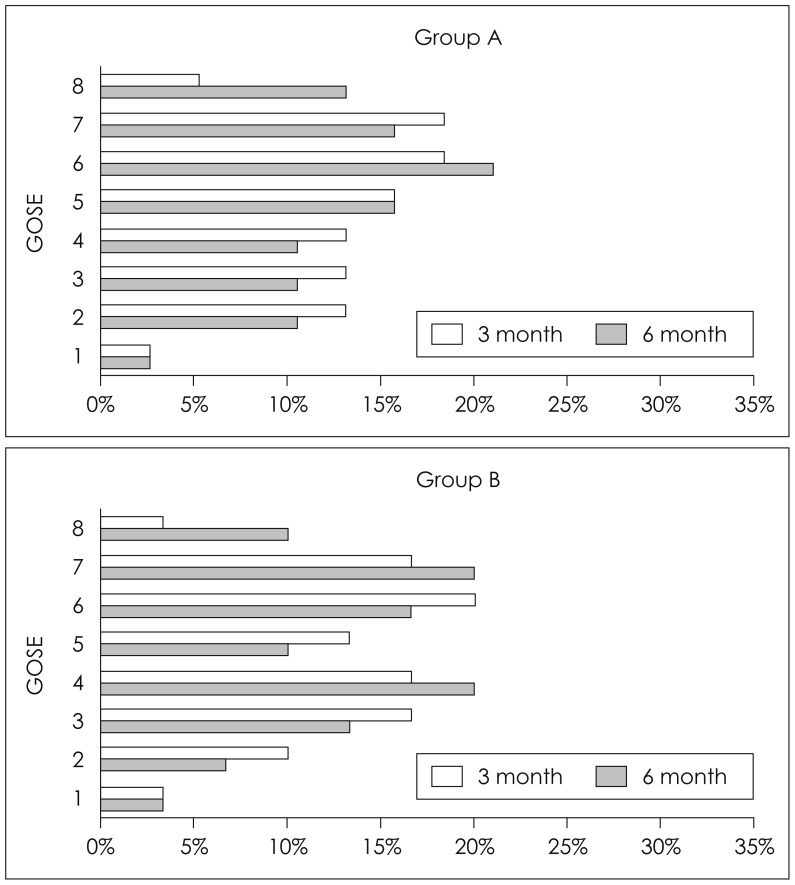Korean J Neurotrauma.
2018 Oct;14(2):99-104. 10.13004/kjnt.2018.14.2.99.
Relationship between Clinical Outcomes and Superior Sagittal Sinus to Bone Flap Distance during Unilateral Decompressive Craniectomy in Patients with Traumatic Brain Injury: Experience at a Single Trauma Center
- Affiliations
-
- 1Department of Neurosurgery and Medical Research Institute, Pusan National University Hospital, Pusan National University School of Medicine, Busan, Korea. csfdiver@naver.com
- KMID: 2424320
- DOI: http://doi.org/10.13004/kjnt.2018.14.2.99
Abstract
OBJECTIVE
This retrospective study was conducted to investigate the relationship between the superior sagittal sinus (SSS) to bone flap distance and clinical outcome in patients with traumatic brain injury (TBI) who underwent decompressive craniectomy (DC).
METHODS
A retrospective review of medical records identified 255 adult patients who underwent DC with hematoma removal to treat TBI at our hospital from 2016 through 2017; of these, 68 patients met the inclusion criteria and underwent unilateral DC. The nearest SSS to bone flap distances were measured on postoperative brain computed tomography images, and patients were divided into groups A (distance ≥20 mm) and B (distance < 20 mm). The estimated blood loss (EBL) and operation time were evaluated using anesthesia records, and the time spent in an intensive care unit (ICU) was obtained by chart review. The clinical outcome was rated using the extended Glasgow Outcome Scale (GOS-E) at 3 and 6 months postoperatively.
RESULTS
The male to female ratio was 15:2 and the mean subject age was 55.12 years (range, 18-79 years). The mean EBL and operation times were significantly different between groups A and B (EBL: 655.26 vs. 1803.33 mL, p < 0.001; operation time: 125.92 vs. 144.83 min, p < 0.001). The time spent in the ICU and GOS-E scores did not differ significantly between the groups.
CONCLUSION
We recommend that when DC is indicated due to TBI, an SSS to bone flap distance of at least 20 mm should be maintained, considering the EBL, operation time, and other outcomes.
MeSH Terms
Figure
Reference
-
1. Adewumi D, Colohan A. Decompressive craniectomy: Surgical indications, clinical considerations and rationale. In : Agrawal A, editor. Brain injury: Pathogenesis, monitoring, recovery and management. Rijeka, HR: InTech;2012. p. 475–486.2. Bernard AC, Davenport DL, Chang PK, Vaughan TB, Zwischenberger JB. Intraoperative transfusion of 1 U to 2 U packed red blood cells is associated with increased 30-day mortality, surgicalsite infection, pneumonia, and sepsis in general surgery patients. J Am Coll Surg. 2009; 208:931–937. 937.e931–937.e932. PMID: 19476865.
Article3. Burger R, Duncker D, Uzma N, Rohde V. Decompressive craniotomy: durotomy instead of duroplasty to reduce prolonged ICP elevation. Acta Neurochir Suppl. 2008; 102:93–97. PMID: 19388296.
Article4. Citerio G, Andrews PJ. Refractory elevated intracranial pressure: intensivist's role in solving the dilemma of decompressive craniectomy. Intensive Care Med. 2007; 33:45–48. PMID: 17019546.
Article5. Cooper DJ, Rosenfeld JV, Murray L, Arabi YM, Davies AR, D'Urso P, et al. Decompressive craniectomy in diffuse traumatic brain injury. N Engl J Med. 2011; 364:1493–1502. PMID: 21434843.
Article6. Guerra WK, Gaab MR, Dietz H, Mueller JU, Piek J, Fritsch MJ. Surgical decompression for traumatic brain swelling indications and results. J Neurosurg. 1999; 90:187–196. PMID: 9950487.
Article7. Huang X, Wen L. Technical considerations in decompressive craniectomy in the treatment of traumatic brain injury. Int J Med Sci. 2010; 7:385–390. PMID: 21103073.
Article8. Huang YH, Lee TC, Chen WF, Wang YM. Safety of the nonabsorbable dural substitute in decompressive craniectomy for severe traumatic brain injury. J Trauma. 2011; 71:533–537. PMID: 21768912.
Article9. Hutchinson PJ, Corteen E, Czosnyka M, Mendelow AD, Menon DK, Mitchell P, et al. Decompressive craniectomy in traumatic brain injury: the randomized multicenter RESCUEicp study (www. RESCUEicp.com). Acta Neurochir Suppl. 2006; 96:17–20. PMID: 16671415.10. Jiang JY, Xu W, Li WP, Xu WH, Zhang J, Bao YH, et al. Efficacy of standard trauma craniectomy for refractory intracranial hypertension with severe traumatic brain injury: a multicenter, prospective, randomized controlled study. J Neurotrauma. 2005; 22:623–628. PMID: 15941372.
Article11. Ko K, Segan S. In situ hinge craniectomy. Neurosurgery. 2007; 60:255–258. PMID: 17415161.
Article12. Kolias AG, Adams H, Timofeev I, Czosnyka M, Corteen EA, Pickard JD, et al. Decompressive craniectomy following traumatic brain injury: developing the evidence base. Br J Neurosurg. 2016; 30:246–250. PMID: 26972805.
Article13. Mebust WK, Holtgrewe HL, Cockett AT, Peters PC. Transurethral prostatectomy: immediate and postoperative complications. A cooperative study of 13 participating institutions evaluating 3,885 patients. J Urol. 1989; 141:243–247. PMID: 2643719.14. Mor E, Jennings L, Gonwa TA, Holman MJ, Gibbs J, Solomon H, et al. The impact of operative bleeding on outcome in transplantation of the liver. Surg Gynecol Obstet. 1993; 176:219–227. PMID: 8438192.15. Mori K, Nakao Y, Yamamoto T, Maeda M. Early external decompressive craniectomy with duroplasty improves functional recovery in patients with massive hemispheric embolic infarction: timing and indication of decompressive surgery for malignant cerebral infarction. Surg Neurol. 2004; 62:420–429. PMID: 15518850.16. Murray GD, Butcher I, McHugh GS, Lu J, Mushkudiani NA, Maas AI, et al. Multivariable prognostic analysis in traumatic brain injury: results from the IMPACT study. J Neurotrauma. 2007; 24:329–337. PMID: 17375997.
Article17. Özen OA, Turamanlar O, Kırpıko O, Songur A, Eser O. Superior sagittal sinus bifurcation variation. Eur J Gen Med. 2013; 10:56–58.18. Quinn TM, Taylor JJ, Magarik JA, Vought E, Kindy MS, Ellegala DB. Decompressive craniectomy: technical note. Acta Neurol Scand. 2011; 123:239–244. PMID: 20637010.
Article19. Rosner MJ, Rosner SD, Johnson AH. Cerebral perfusion pressure: management protocol and clinical results. J Neurosurg. 1995; 83:949–962. PMID: 7490638.
Article20. Sisk AL, Hammer WB, Shelton DW, Joy ED Jr. Complications following removal of impacted third molars the role of the experience of the surgeon. J Oral Maxillofac Surg. 1986; 44:855–859. PMID: 3464711.
Article21. Skoglund TS, Eriksson-Ritzén C, Jensen C, Rydenhag B. Aspects on decompressive craniectomy in patients with traumatic head injuries. J Neurotrauma. 2006; 23:1502–1509. PMID: 17020484.
Article22. Stiefel MF, Heuer GG, Smith MJ, Bloom S, Maloney-Wilensky E, Gracias VH, et al. Cerebral oxygenation following decompressive hemicraniectomy for the treatment of refractory intracranial hypertension. J Neurosurg. 2004; 101:241–247. PMID: 15309914.
Article23. Stocchetti N, Maas AI. Traumatic intracranial hypertension. N Engl J Med. 2014; 370:2121–2130. PMID: 24869722.
Article24. Stocchetti N, Rossi S, Buzzi F, Mattioli C, Paparella A, Colombo A. Intracranial hypertension in head injury: management and results. Intensive Care Med. 1999; 25:371–376. PMID: 10342510.
Article25. Timofeev I, Czosnyka M, Nortje J, Smielewski P, Kirkpatrick P, Gupta A, et al. Effect of decompressive craniectomy on intracranial pressure and cerebrospinal compensation following traumatic brain injury. J Neurosurg. 2008; 108:66–73. PMID: 18173312.
Article26. Timofeev I, Dahyot-Fizelier C, Keong N, Nortje J, Al-Rawi PG, Czosnyka M, et al. Ventriculostomy for control of raised ICP in acute traumatic brain injury. Acta Neurochir Suppl. 2008; 102:99–104. PMID: 19388297.
Article27. Vahedi K, Vicaut E, Mateo J, Kurtz A, Orabi M, Guichard JP, et al. Sequential-design, multicenter, randomized, controlled trial of early decompressive craniectomy in malignant middle cerebral artery infarction (DECIMAL Trial). Stroke. 2007; 38:2506–2517. PMID: 17690311.
Article28. Valença MM, Martins C, da Silva JC, Mendonça CMF, Ambrosi PB, Andrade-Valença LPA. An innovative technique of decompressive craniectomy for acute ischemic stroke. In : Balestrino M, editor. Advances in the treatment of ischemic stroke. Rijeka, HR: InTech;2012. p. 227–246.29. Wagner S, Schnippering H, Aschoff A, Koziol JA, Schwab S, Steiner T. Suboptimum hemicraniectomy as a cause of additional cerebral lesions in patients with malignant infarction of the middle cerebral artery. J Neurosurg. 2001; 94:693–696. PMID: 11354398.
Article30. Wang YS, Wang Y, Shi XW, Zhang JD, Ma YY. Size of bone flap and bone window area may impact the outcome of decompressive craniectomy using standard bone flap. Eur Rev Med Pharmacol Sci. 2016; 20:3679–3682. PMID: 27649670.31. Winston KR. Efficacy of dural tenting sutures. J Neurosurg. 1999; 91:180–184. PMID: 10433304.
Article32. Wirtz CR, Steiner T, Aschoff A, Schwab S, Schnippering H, Steiner HH, et al. Hemicraniectomy with dural augmentation in medically uncontrollable hemispheric infarction. Neurosurg Focus. 1997; 2:E3.
Article
- Full Text Links
- Actions
-
Cited
- CITED
-
- Close
- Share
- Similar articles
-
- Pushed-out Scrylic Bone Flap n Post-traumatic Hydrocephalus
- Decompressive Craniectomy in Traumatic Brain Injury: A Review Article
- Analysis of Cranioplasty Using Frozen Autologous Bone Following Post-Traumatic Decompressive Craniectomy
- The relationship between the serum lactate level and in-hospital mortality after decompressive craniectomy in traumatic brain Injury
- Post-Traumatic Cerebral Infarction Following Low-Energy Penetrating Craniocerebral Injury Caused by a Nail




